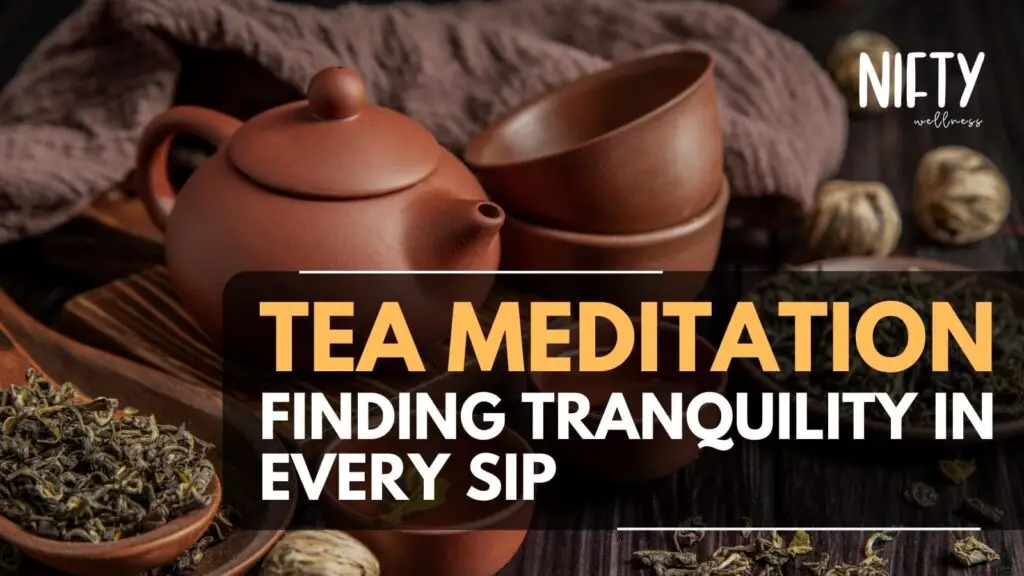Finding a time of quiet reflection to allow ourselves to relax and enjoy the present entirely can seem complicated in our fast-paced lives. With the myriad of stressors demanding our attention, we never get a truly peaceful moment. But what if I told you that entering a state of serenity and tranquillity is as simple as having a cup of tea?
Enter the world of tea meditation, the perfect meditation suited to the modern lifestyle. Let the calming properties of tea and the grounding practice of meditation come in sync to present the symphony of tea meditation.
History of Tea Meditation
It is common knowledge that tea meditation is a version of mindfulness meditation practiced in many Zen households and temples. Looking closer at the concentrated practice and the literal meaning behind tea meditation will give a clearer insight into the philosophy in Zen society.
As a general practice, meditation helps with relaxation, focus, and acceptance. While many people associate this technique with sitting silently in the lotus position, meditation can be practiced anywhere at any time, during any activity—even tea.
Philosophy of Here & Now
Unplugging and enjoying the present moment is often tricky in a technology-dominated world. Tea meditation is an easy way to focus on the “here and now.”
Prepare a cup of tea at a suitable time of the day. It doesn’t matter whether it’s black, green, or herbal tea. Pick your favourite flavour, or toss a favourite tea bag over ice. Next, secure a quiet spot to sit, take a deep breath, and let the scents of tea from your cup take over you. Take a sip—but before you swallow, think about the leaves that created the beverage in the first place. How were they picked? What temperature water infused their flavor for your enjoyment? Reflect upon the time you’ve set aside to enjoy one simple, extraordinary act: drinking tea. That brief moment of slowness alone can help centre your mind.
Tea Meditation, Zen & Buddhism

While sipping, focus on how the liquid travels from the mug, across your lips and tongue, and into your throat. Concentrate on those sensations as you inhale and exhale.
Savor the flavor that finds its way to the taste buds. Notice the coolness on your tongue when drinking iced tea or the warmth generated inside if you’re sipping hot tea.
Observe the emotional responses your mind conjures during this simple and necessary pastime.
Tea meditation is a beautiful blend of tea and mindfulness, often rooted in Zen Buddhism and other cultural practices. This is about savouring a tea without judgment and being fully present in the moment, leaving the chaos of the outside world until after you’ve had this ritual of self-care and self-love.
Check out our blog Best Japanese Green Tea & How To Brew Them. Experience the essence of Japan through the aromatic world of green tea.
The Tea Meditation Ritual

“The process of tea meditation is about slowly and intentionally preparing the tea, savoring the warmth and the taste, and reflecting on your understanding of appreciation, gratitude, and interdependence,” said Diana.
Now that you have the answer to “What is tea meditation?”, let us go to the how part, that is, how to combine tea and meditation.
A Symphony of Senses: The Art of Tea Meditation
Step 1: Intentional Beginnings
Begin each tea meditation by intending to be present, thoroughly enjoy the tea’s warmth, and reflect on our world’s connectedness. This helps signal to retire from other cares and duties and invites our mind to “arrive.”
Step 2: Mindful Preparation
Slowly take out the tea leaves (not in a rushed way, as the leaves’ aroma would strike you) from a jar or container and place them in a teapot or gaiwan.
Step 3: Contemplative Observation
Look at the tea – shape, size, colour, sheen, and smell as you take this time-honoured plant medicine. Try to see the entire picture of the tea, its energy, and its condition.
Step 4: Steeping Awareness
On each meditation, notice the act of steeping the tea leaves in hot water once, release, peel, discard, and observe this movement between boiling water and tea.
Step 5: Sensory Connection
As you pour the first tea into the cups, note the color of the tea. Notice the smell again. How is the aroma now the same or different after the steep has been poured out? What memories, emotions, or ideas has this evoked in you?
Step 6: Mindful Sip
Holding tea, at this point, reflect on what stands out about this sip – taste, texture, mouth feel, depth, quality, or absence of after-taste – and record something substantial.
Step 7: Reflect and Explore
Read what you have written and sit with your reflection; is there something significant that you want to be sure to retain? Is there something that you are curious about and would like to check out more on the Internet?
Read our blog Top 9 Japanese Green Tea Brands & Green Tea Health Benefits. Dive into the world of exceptional Japanese green tea brands and also explore the benefits of green tea for your health.
Selecting the Appropriate Tea for Meditation
The key to the perfect meditation session? Selecting your ideal meditation tea. Firstly, there is no such thing as the best tea for meditation. Whether you prefer the clarity of green tea, chamomile’s calming touch, or herbal blends’ gentle hug, different teas have different flavor profiles and body effects. Here is a list of teas you can try & find the perfect tea for your meditation journey.
Finding the Best Tea to Enhance Your Meditation Experience
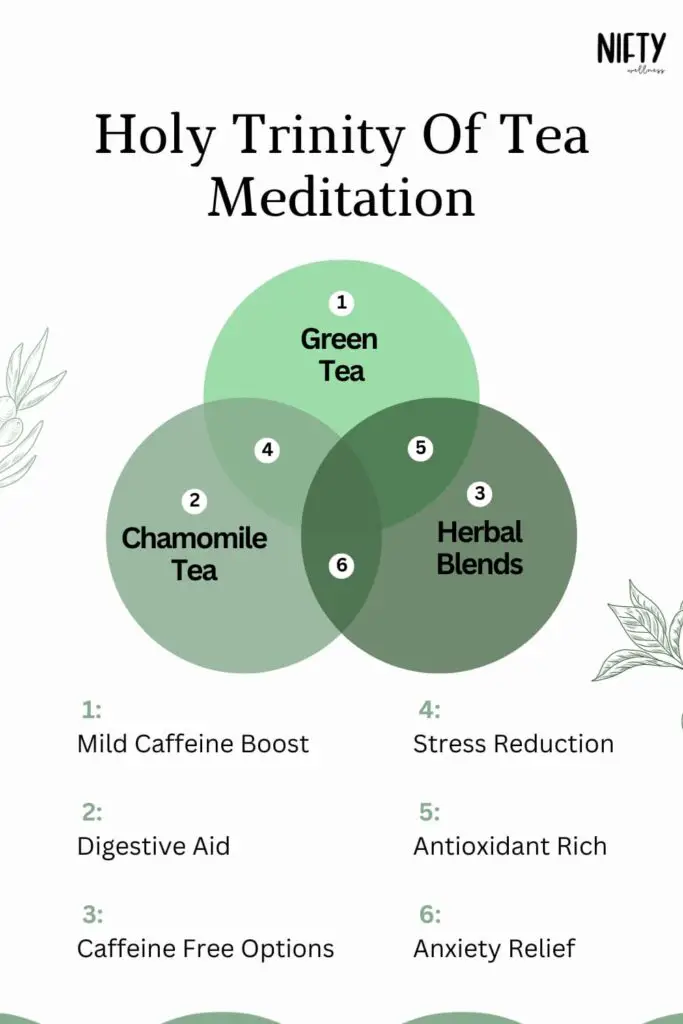
Green Tea
It is known for its gentle energy boost and grassy notes.
Chamomile Tea
Renowned for its calming effects and mild, floral taste.
Herbal Blends
Lavender and mint blends can create a tranquil atmosphere.
White Tea
Delicate and subtly sweet, it is perfect for a serene meditation.
Rooibos Tea
Naturally caffeine-free with a rich, earthy flavour.
Jasmine Tea
Infused with the fragrance of jasmine blossoms, it adds an aromatic dimension to your practice.
Peppermint Tea
It is invigorating and refreshing, ideal for enhancing alertness during meditation.
Lemon Balm Tea
Offers a citrusy and soothing profile for a relaxed mindfulness session.
Steps on Practicing a Tea Meditation
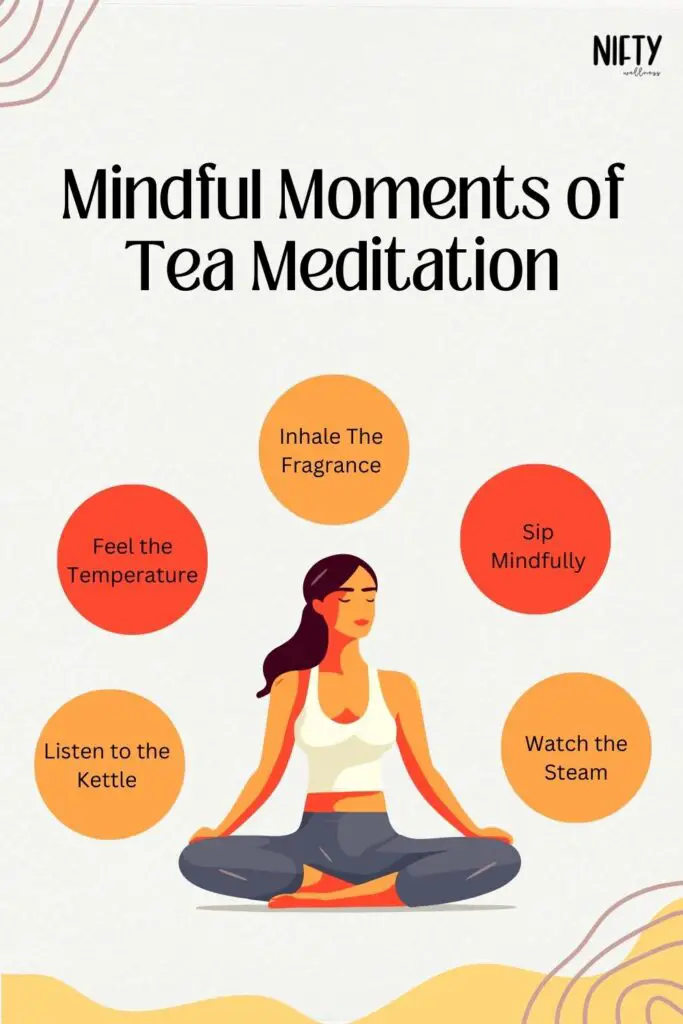
Curious about how to achieve peace and tranquility through brewing? If you’re starting and curious about how to practice tea meditation yourself, you’re lucky because tea meditation is simple!
All you need is a quiet space, a kettle, hot water, tea leaves, and cups. I’ll tell you everything you need to know below and how to practice tea meditation.
Find a Quiet Space
Make sure you find a quiet space to practice undisturbed. It doesn’t have to be completely silent, just someplace to enjoy your tea.
Prepare Your Tea
Boil the kettle. Watching the kettle is much more relaxing, but it will produce better tea if you give it time to rest from the boil. I recommend boiling the kettle and counting to 20 before pouring the water into your teapot.
Focus Your Attention
As a sitting practice, tea meditation is an opportunity to develop our ability to pay full attention to our experience moment by moment. So once you have prepared the water, focus 100% of your attention on the water.
Engage Your Senses
Prepare to practice tea meditation by opening your senses to the whole experience of the tea and tea ceremony meditation. Notice the colour and shapes of the tea cups. Feel the temperature of the teapot. Inhale and let the fragrance of the tea rise in you. Then, taste and savour it. Allow yourself to linger and enjoy each aspect of the process.
Want to start tea meditation practice on your own? Choose your favourite tea from the best teas for meditation, and then follow this step-by-step guide!
- Pinch the leaves
- Smell and savor the aroma
- Heat the pot and the cups
- Listen to the whistle of the kettle
- Watch the steam as it rises to the top
- Slowly pour the water into the pot
- Pour the tea lovingly into the cup
- Bring the cup to your lips
- Taste and savour
Benefits of Tea Meditation
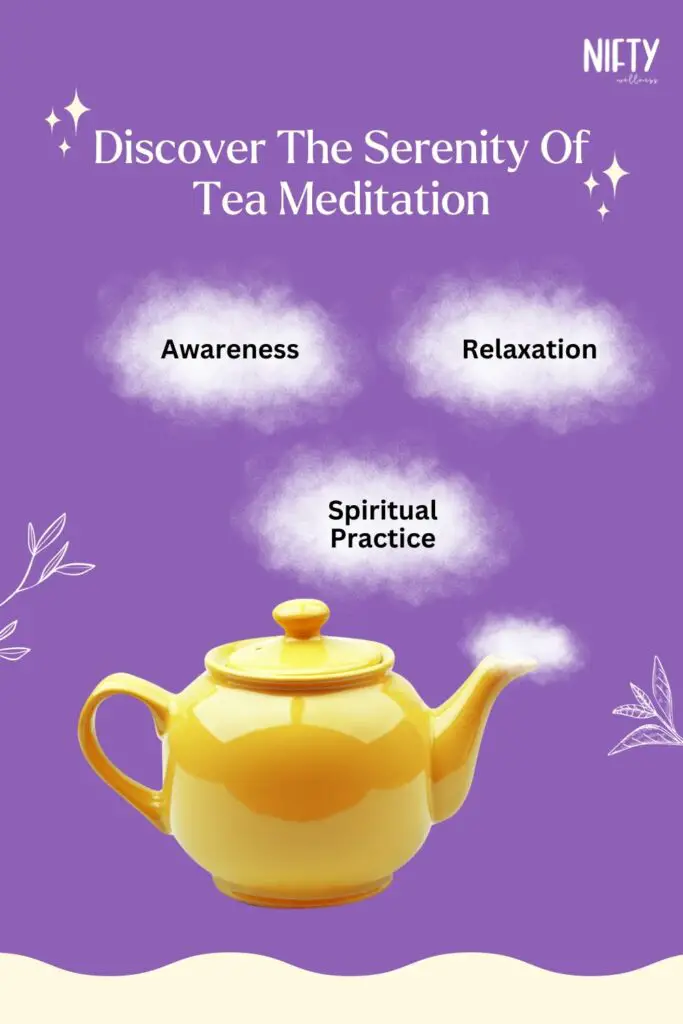
Do you want to know what happens during a tea meditation? How does it help you calm down and enter a state of tranquility? Here is a list of the benefits of tea meditation:
Relaxation
Tea meditation offers a moment of tranquility and relaxation. Taking a break from our overly busy routines to savour the flavour of tea can help rejuvenate the body and mind.
Awareness
Mindfulness is another benefit of tea meditation. It helps us stay present and be attentive to what we do and where we are. At first, it may be challenging to put all other concerns aside and concentrate on our tea alone. However, once we develop mindfulness, outside thoughts will fade away naturally.
Spiritual practice
The use of tea as part of a spiritual practice has a long history. Initially in China in the 10th century, Buddhists to help them stay awake during meditation, tea, and meditation have been linked for nearly a millennium. Some of the best monastic tea practitioners in the world still live, practice, and teach within Zen temples in Japan.
Alternatives
Are you not a tea person? No worries! You can still harness the benefits of meditation with your daily routine. A walk can be as powerful as a seated tea mindfulness session, especially if you catch yourself wandering off into past/future time and pull yourself back to the present moment and sense the world through your feet touching the ground.
Indulge in the harmonious serenity of a warm cup of Sedative Magenta, brewed with our Yuletide Relaxation unique blend of herbs and caffeine-free reds. With hints of tranquil, calm, and relaxed serenities, this tea is the consummate choice for taking the edge off after an overextended holiday. One highlight of this tea is that it allows pure relaxation with tranquility. Immerse your spirit in a calm state with each sip of Sedative Magenta.
Tea meditations have profound benefits, including stress reduction, anxiety relief, increased focus, and overall well-being. The chaos around us, which would typically seem unmanageable and leave us feeling somewhat drained, can be managed by simply sitting and focusing on a cup of tea.
Tea Meditation: The Peaceful Pause in a Busy Life
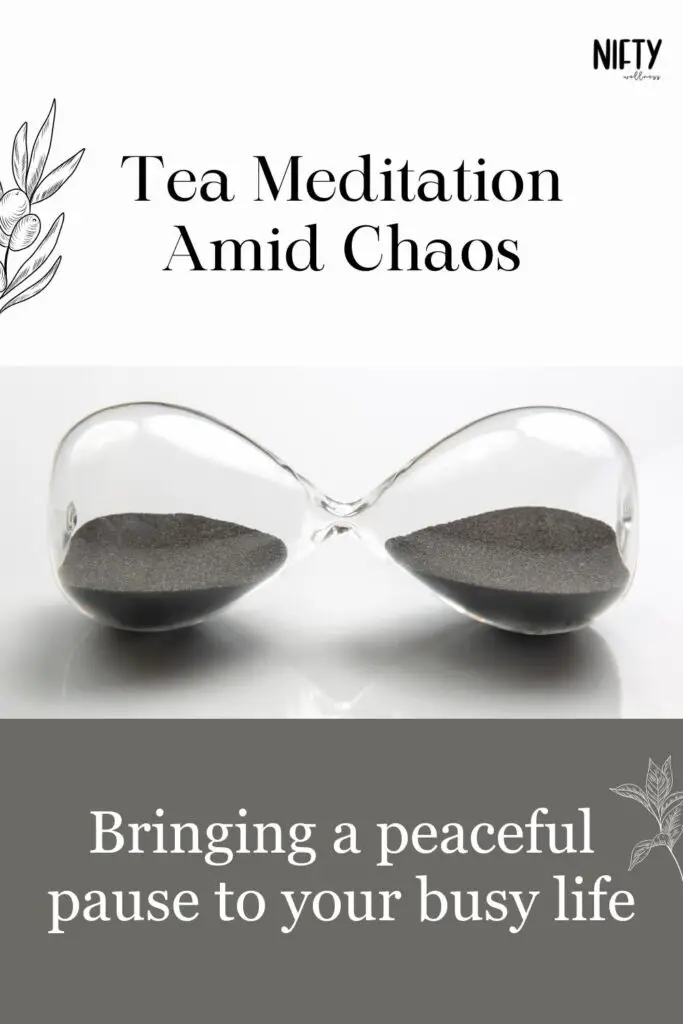
We know life is busy, but tea meditation offers a way to experience a tranquil state of mind. You now know how to work a tea meditation into a busy day and create a place at home or work for tea drinking to promote a peaceful state of mind.
In tea meditation, each sip is a moment of peace, a breath of fresh air in the chaos of life. As you embark on the journey of tea meditation, you will realize that this transformation can happen for you, too. It isn’t simply tea. It is the balance. It is mindfulness. It is the peace that has somehow been infused into your daily routine.
Frequently Asked Questions (FAQs)
What type of tea is best for meditation?
The best tea for meditation often depends on personal preferences and goals. With its gentle caffeine boost, green tea can enhance alertness during meditation. On the other hand, Chamomile tea is famous for its calming properties. Herbal blends, for example, lavender and mind, are known for relaxation. In the end, the choice lies with the individual and their preference.
Can I practice tea meditation with others?
Yes, you can practice tea meditation with others. You can gather peacefully, brew tea together, and engage in the practice as a group, savouring each sip mindfully and cherishing the present moment. You can all get together in a calm place, make tea, and do meditation as a group. It’s like enjoying each tea sip while entirely in the moment.
How long should a tea meditation session last?
A tea meditation session can vary in length, but it’s often best to start with about 15-20 minutes. This gives you enough time to brew and savour your tea mindfully without feeling rushed. You can extend the session to 30 minutes or longer as you get more comfortable with the practice. The key is to find a duration that feels calming and enjoyable for you.
Is it necessary to have a special teapot?
No, you don’t need a special teapot for tea meditation. While some people prefer traditional teapots, you can use any clean teapot or cup. The focus is on the mindfulness of the tea-drinking process, not the teapot itself. Use what you have and feel comfortable with; the magic is in the meditation, not the vessel.
Can I use tea bags for tea meditation?
Yes, you can use tea bags for tea meditation. Simply choose your favorite tea bag, follow meditation, and enjoy the calming experience. The essence of tea meditation is in being present and savoring each moment, regardless of the tea form you choose.
